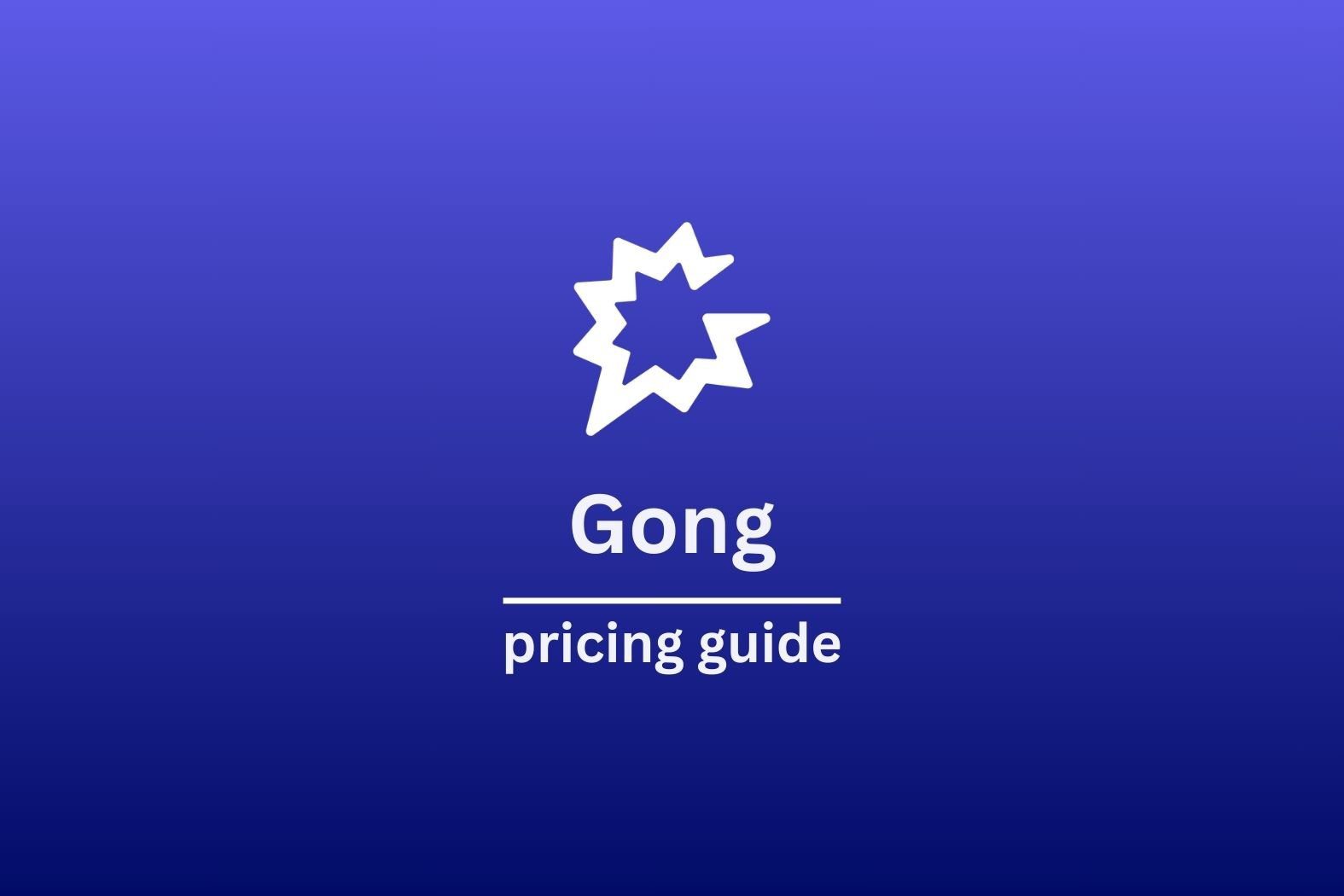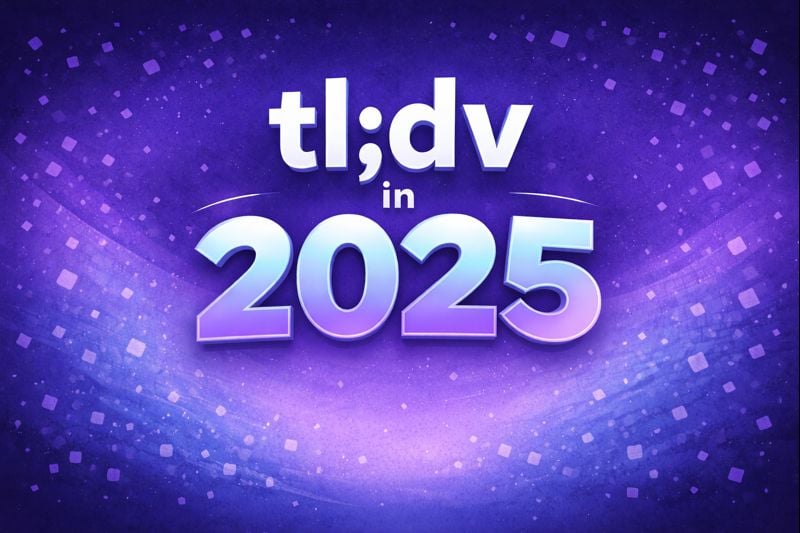tl;dv vs Read.ai - lequel de ces deux outils pilotés par l'IA est le meilleur pour vous et votre entreprise ?
Vous arrive-t-il d'être submergé par le volume d'informations lors des réunions ? Il est universellement admis que les réunions sont souvent une perte de temps. Ce fait a été réaffirmé par une étude récente de Microsoft, qui a révélé que 57 % de notre journée de travail est consacrée à la communication, ce qui ne laisse que 43 % à la création.
tl;dv et Read.ai sont deux leaders de la prise de notes par IA conçus pour remédier à l'inefficacité même des réunions. Ces plateformes offrent des fonctionnalités robustes pour la gestion des réunions, des transcriptions précises et des suivis exploitables, ce qui est crucial pour toute personne cherchant à optimiser son temps et à se concentrer sur ce qui compte vraiment dans son entreprise.
Dans ce guide pratique, nous examinerons les différentes caractéristiques et capacités de chaque plateforme, en comparant tl;dv, un outil basé dans l'UE, avec tl;dv, un outil basé dans l'UE. Read.aibasé aux États-Unis. Nous explorerons les caractéristiques uniques de chaque outil, leurs points forts et les domaines dans lesquels ils peuvent s'avérer insuffisants.
Préparez-vous à découvrir comment ces outils s'intègrent à votre configuration technologique existante, améliorent l'expérience utilisateur, respectent les normes de sécurité, et bien plus encore. Ce guide couvre tout ce que vous devez savoir pour prendre une décision éclairée quant à l'outil de prise de notes par IA qui répondra le mieux aux besoins de votre entreprise.
tl;dr
| tl;dv | Read.ai | |
|---|---|---|
| Transcription | 20 🟢 | 14 |
| Enregistrement | 16 🟢 | 14 |
| Intelligence conversationnelle | 14 | 15 🟢 |
| Automatisation et intégrations | 9 🟢 | 7 |
| Prise de notes | 12 🟢 | 6 |
| Sécurité | 19 🟢 | 8 |
| Coaching | 8 🟢 | 0 |
| Administrateur | 8 🟢 | 4 |
| Organisationnel | 12 🟢 | 10 |
| Service client | 4 🟢 | 2 |
| Revenue Intelligence | 0 | 0 |
| Autres | 8 🟢 | 5 |
| Total | 130 🟢 | 86 |
Dans cette comparaison directe entre tl tl;dv et Read.ai, tl;dv apparaît comme l'assistant de réunion IA le plus polyvalent.
Il est plus adapté aux équipes de vente des PME, tout en conservant un large attrait pour les différents départements tels que les produits, la réussite des clients et l'ingénierie. Il se distingue par son support multilingue, ses capacités de prise de notes associées à des fonctions de coaching, ses mesures de sécurité et ses fonctionnalités organisationnelles étendues.
D'autre part, Read.ai est conçu pour améliorer l'efficacité opérationnelle et est essentiel pour les personnes qui organisent des réunions. Bien qu'il puisse être utilisé dans le cadre d'un espace de travail plus large, de nombreuses fonctions d'administration sont verrouillées dans le plan Entreprise, et la propriété est conservée par l'organisateur de la réunion plutôt que par les dérogations administratives.
Cependant, alors que tl;dv surpasse régulièrement Read.ai dans la plupart des catégories, certains affirment que Read.ai peut avoir un avantage dans l'intelligence conversationnelle, principalement en raison de ses capacités d'analyse des sentiments. Cependant, la conformité de cette fonctionnalité avec les réglementations de l'UE fait l'objet d'un examen minutieux, de sorte que, bien qu'il soit marqué comme une augmentation en considérant cette section particulière comme une victoire, cela est subjectif.
Cette analyse approfondie met en évidence le fait que tl;dv est le meilleur choix pour les entreprises à la recherche d'un assistant de réunion IA complet et adaptatif.
tl;dv vs Read.ai: 12 facteurs à prendre en compte pour choisir la meilleure IA de prise de notes
Quel est notre classement ?
- Nous accordons 2 points à une plateforme lorsqu'elle l'emporte clairement ou lorsque l'autre plateforme fournit un service équivalent.
- Nous accordons 1 point lorsque la plateforme offre le service sans l'emporter sur l'autre.
- Nous accordons 0 point lorsque la plateforme n'offre pas le service en question.
Capacités de transcription
| tl;dv (20) | Read.ai (14) | |
|---|---|---|
| Transcriptions incluses | 🟢 Illimité | 🟠 Limité à 5 sur la place gratuite |
| Transcriptions en temps réel | 🔴 | 🔴 |
| Langues prises en charge | 🟢 +40 | 🟠 7 |
| Dialectes pris en charge | 🟢 | 🔴 |
| Suppression des mots de remplissage | 🔴 soon | 🔴 No, but it does track this |
| Reconnaissance des intervenants | 🟢 | 🟢 |
| Noms des intervenants | 🟢 | 🔴 Ils doivent être ajoutés rétrospectivement |
| Transcrire des téléversements vidéo/audio | 🟢 Plafonné à 3 enregistrements par mois sur le plan gratuit | 🟠 Uniquement pour les services payants et plafonnés en fonction du niveau de l'échelon ou par l'achat de crédits |
| Exporter des transcriptions | 🟢 | 🟢 |
| Créer des clips à partir de transcriptions | 🟢 | 🟢 |
| Vocabulaire personnalisé | 🔴 soon | 🟠 Mais uniquement sur les comptes payants et limité à 100 mots |
| Recherche dans l'ensemble des transcriptions | 🟢 | 🟢 |
| Éditer la transcription | 🟢 | 🟢 |

Langues prises en charge
Read.ai est extrêmement limité par rapport à tl;dv en ce qui concerne les langues. Alors que le logiciel prend en charge 7 langues (dont l'anglais), les appels vidéo et la transcription, il est limité dans ses autres domaines. L'outil peut scanner et lire des emails mais ne le fait qu'en anglais et en espagnol. De même, la page "Pour vous" n'est disponible qu'en anglais ou en espagnol.
tl;dv permet toutefois la traduction dans plus de 40 langues. Dans un monde globalisé, tl;dv est le meilleur choix pour fournir des services de transcription inclusifs.
Dialectes pris en charge
Les capacités linguistiques impressionnantes de tl;dvsont également renforcées par la prise en charge des dialectes. Cela offre encore plus de précision et d'accessibilité aux utilisateurs de langues et de dialectes différents. Cela permet de s'assurer que les accents régionaux, qui sont nombreux, sont capturés et traduits avec précision. Il ne s'agit pas d'une fonctionnalité de Read.ai qui pourrait limiter le nombre d'utilisateurs capables d'en tirer le meilleur parti - même si votre équipe est basée dans le même pays.
Suppression des mots de remplissage
Ni tl;dv ni Read.ai n'offrent pour l'instant la possibilité de supprimer les mots de remplissage. Read.ai suit ces mots dans le cadre de ses mesures, mais il s'agit davantage d'un point de données. tl;dv est en train de l'ajouter à ses services de transcription. Cette fonctionnalité à venir permettra de produire des transcriptions plus propres et plus concises en éliminant les mots et les phrases inutiles, ce qui constituera un futur facteur de différenciation entre les deux outils.
Transcrire des téléversements vidéo/audio
Les deux plateformes permettent la transcription à partir de fichiers audio/vidéo téléchargés. Cependant, Read.ai ne le permet que pour les forfaits de niveau supérieur, à partir de 100 minutes par mois pour le forfait de base payant. Des minutes supplémentaires peuvent être achetées pour environ 20 $ par 500 minutes, plus la taxe de vente locale.
Vocabulaire personnalisé
Actuellement, Read.ai prend en charge le vocabulaire personnalisé, mais uniquement pour les niveaux de paiement les plus élevés et est limité à 100 mots. Sur tl;dv, la possibilité d'incorporer un vocabulaire personnalisé dans les transcriptions est une fonctionnalité à venir pour tl;dv, visant à améliorer la précision pour les exigences linguistiques techniques ou spécifiques à l'industrie.
Capacités d'enregistrement
| tl;dv (16) | Read.ai (14) | |
|---|---|---|
| Plateformes vidéo | 🟢 Zoom, MS Teams, Google Meet | 🟢 Zoom, MS Teams, Google Meet, Webex, Slack |
| Stockage | 🟢 Illimité | 🟢 Illimité |
| Enregistre la vidéo | 🟢 | 🟢 |
| Réunions simultanées | 🟢 Illimité | 🔴 |
| Télécharger des enregistrements | 🟢 | 🟢 |
| Capture les diapositives | 🟢 | 🔴 |
| Analyse des visionnages | 🟢 | 🔴 |
| Calendrier intégré | 🔴 | 🔴 |
| Édition d'enregistrements | 🔴 | 🟢 |
| Reels | 🟢 | 🟢 |
Plateformes vidéo
tl;dv offre des fonctionnalités pour les réunions sur Zoom, MS Teams et Google Meet, ce que propose également Read.ai Cependant, Read.ai offre également des fonctionnalités pour Webex et propose un lien pour Slack.
Autre point à noter : si vous optez pour la version gratuite ou Pro de Read.ai , vous ne pourrez pas visionner la vidéo de la réunion. Vous aurez accès aux transcriptions et aux points d'action, mais pas à la vidéo elle-même.
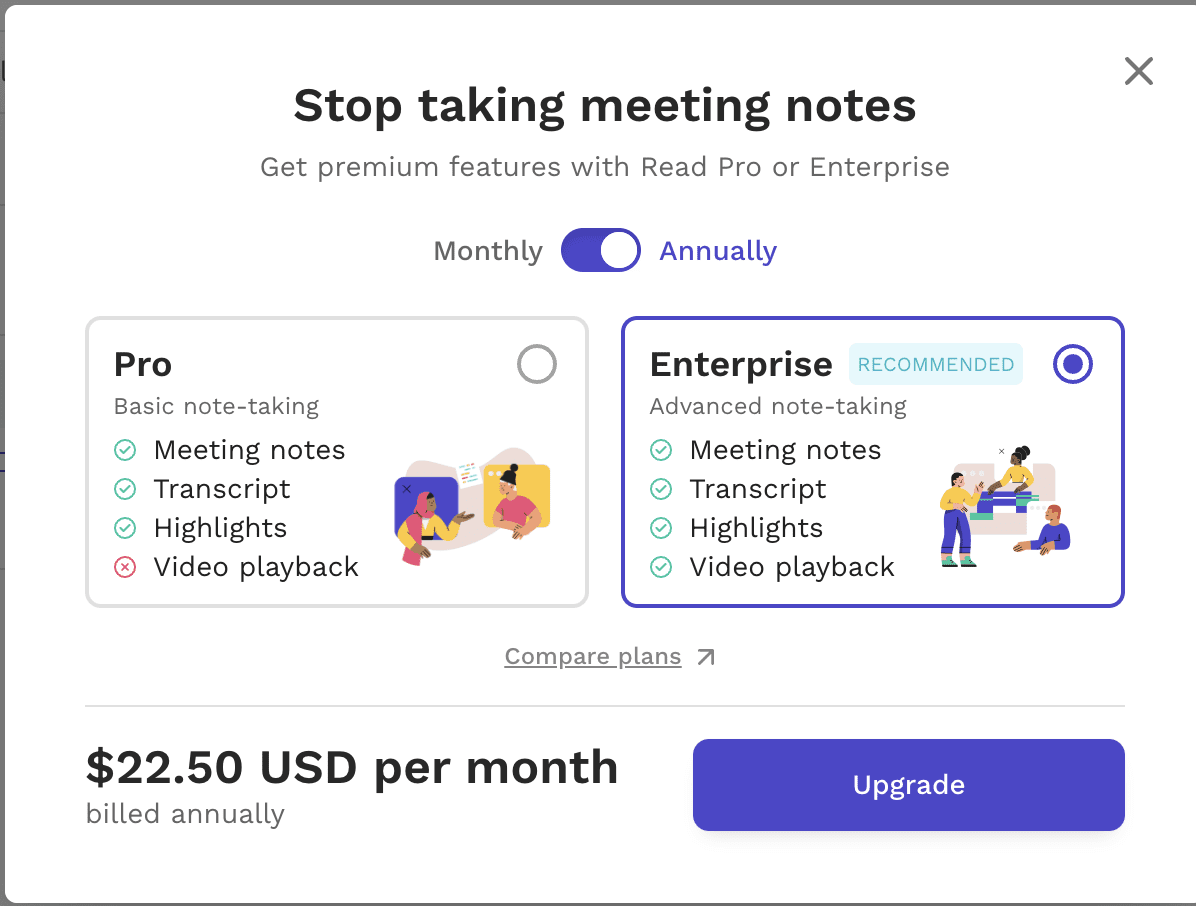
Réunions simultanées
Si vous avez besoin d'organiser des réunions simultanées, tl;dv le permet sur toutes les plateformes de réunion qu'il prend en charge. Cela en fait un outil idéal pour les grandes organisations ou les équipes dont le programme de réunions est chargé. Rien n'échappe à la règle, quelle que soit la nature de la réunion en cours.
Read.ai n'offre pas cette possibilité, d'après ce que nous avons pu constater. Cela est probablement dû au fait que l'outil est directement lié au compte d'un individu. Cela signifie que si vous pouvez envoyer le robot à une réunion à laquelle vous n'assistez pas, il n'est pas certain que vous puissiez également enregistrer la réunion à laquelle vous participez.
Calendrier intégré
Bien que tl;dv fonctionne avec votre calendrier, Read y est totalement intégré au point de pouvoir vous recommander des rendez-vous, etc. Il peut également regrouper plusieurs calendriers de Microsoft, Google et d'autres plateformes.
Capture Slides
tl;dv offre la possibilité de capturer des diapositives pendant les réunions, en incorporant des aides visuelles et des présentations dans les enregistrements pour une capture plus complète de la réunion. Cette fonction est inestimable dans les environnements éducatifs et collaboratifs où les diapositives jouent un rôle central dans les discussions. En revanche, Read.ai ne dispose pas de cette fonction, ce qui peut entraîner l'omission d'éléments visuels importants dans les enregistrements de réunions.
Analyse des visionnages
Des analyses de visionnage sont disponibles sur tl;dv, offrant des informations sur la manière dont les utilisateurs s'engagent dans les enregistrements. Cela signifie qu'après une réunion, lorsqu'un enregistrement est visionné, vous pouvez voir quand cela s'est produit et qui l'a visionné. Cette fonction est particulièrement utile pour les ventes, car elle indique que si un prospect visionne l'enregistrement ou le partage avec d'autres, c'est qu'il y a un intérêt et qu'il vaut la peine de le suivre.
D'après nos recherches, il ne semble pas que Read.ai propose des analyses de visualisation sur les réunions elles-mêmes. Sans ces analyses, vous risquez de manquer des données qui pourraient être considérées comme utiles dans certains contextes tels que les ventes, ce qui limite la capacité à évaluer les suivis ou à déterminer si les sujets et le contenu de la réunion ont été jugés "utiles" et s'ils sont révisés.
Capacités d'intelligence conversationnelle
| tl;dv (14) | Read.ai (15) | |
|---|---|---|
| Données clés fournies par l'IA sur 1 réunion | 🟢 | 🟢 |
| Données clés multi-réunions fournies par l'IA | 🟢 | 🟠 |
| Suivi des mots-clés | 🟢 | 🟢 |
| Analyse des sentiments | 🔴 Non (loi eur. sur l'IA) | 🟢 |
| Détection des thèmes clés | 🟢 | 🟢 |
| Analyse de la parole | 🟢 | 🟢 |
| Détection des points d'action | 🟢 | 🟢 |
| Détection des questions | 🟢 | 🟢 |

Données clés fournies par l'IA sur 1 réunion
Les deux outils offrent des informations d'IA pour les réunions individuelles dans tous leurs plans, offrant aux utilisateurs une analyse précieuse et des informations exploitables pour toute réunion individuelle disponible dans la bibliothèque de réunions. Les deux outils sont légèrement différents, tl;dv se basant principalement sur le contenu des réunions, plutôt que sur le contexte. Le niveau supplémentaire d'analyse des sentiments et de notation des conversations de Read.ai couvre des éléments tels que le "charisme", la "partialité" et des éléments tels que le langage non inclusif.
Read.ai offre également des informations d'une manière plus présomptive. Alors que tl;dv vous permet de poser des questions et fournit un résumé des points clés, Read.ai fait davantage de généralisations. Nous avons également constaté que des réactions "négatives" étaient parfois signalées dans les conversations, alors que ce n'était pas le cas.
Données clés multi-réunions fournies par l'IA
tl;dv se distingue en offrant des informations sur l'IA dans le cadre de plusieurs réunions, ce qui permet aux organisations de suivre les tendances, de recueillir des informations au fil du temps et de prendre des décisions éclairées sur la base d'une analyse complète des données.
Il s'agit d'une fonction précieuse non seulement pour les personnes qui souhaitent compiler les sujets abordés, les mesures à prendre et les enseignements tirés de plusieurs réunions en même temps, mais aussi pour les responsables qui souhaitent avoir un aperçu occasionnel de la manière dont les clients les plus importants sont gérés.
Read.ai propose également ce qu'il appelle la découverte automatique de sujets. Il surveille toutes vos réunions, vos réactions, vos actions et vos sentiments et crée une sorte de "page pour vous", à l'instar des médias sociaux, sur les sujets qui semblent les plus importants pour vous dans le cadre de nombreuses réunions.
Bien qu'il s'agisse d'une fonction intéressante, qui permet d'identifier les passions, les projets clés et les sentiments de l'orateur, elle risque de filtrer les éléments moins bons. On a l'impression que cela pourrait conduire à une pasteurisation de l'ensemble des réunions en raison de la partialité de l'algorithme de l'outil. Contrairement à d'autres solutions, il ne permet pas non plus aux utilisateurs de sélectionner des réunions et de les interroger.
Analyse des sentiments
L'analyse des sentiments est l'une des fonctions de Read.ai . Elle utilise l'apprentissage automatique, les indices visuels et verbaux pour évaluer les sentiments de l'orateur et des autres membres de l'appel afin de déterminer des éléments tels que la partialité et l'engagement.
Cette possibilité n'est pas offerte par tl;dv en raison de la loi européenne sur l'IA, qui a classé certaines applications de l'IA, y compris certains éléments de l'analyse des sentiments, comme étant "à haut risque". Cela signifie qu'elles sont susceptibles d'avoir un impact sur les droits fondamentaux et la vie privée des utilisateurs, et qu'elles peuvent être affectées par des préjugés et des évaluations injustes.
Il est très important de garder cela à l'esprit si votre entreprise travaille dans le monde entier, car des éléments tels que la communication non verbale, le ton de la voix et d'autres nuances peuvent être influencés par la culture. Cela peut signifier que certaines choses peuvent être considérées comme "négatives" alors que ce n'est pas le cas, et vice versa.
Détection des actions et des questions
Les réunions sont généralement l'occasion de convenir de plans d'action et de feuilles de route pour les activités et de les finaliser. Ceux-ci sont pris en compte à la fois par tl;dv et Read.ai L'IA intelligente note les questions posées pour en faire des points saillants, et identifie également ce qui doit être fait et par qui à l'issue de la réunion. Ces informations sont ensuite envoyées par la plateforme sous la forme d'un courrier électronique, prêt à être traité par chaque membre de l'équipe en fonction des besoins.

Capacités d'automatisation et d'intégration
| tl;dv (9) | Read.ai (7) | |
|---|---|---|
| Intégrations CRM | 🟠 dans le plan Pro | 🟠 Dans le cadre d'un plan payant utilisant des webhooks |
| Intégrations d'e-mails | 🟢 | 🟢 |
| Intégrations Zapier | 🟢 dans le plan Pro | 🟢 en régime indemnisé |
| E-mail de synthèse post-réunion | 🟢 | 🟢 |
| Programmez des rapports | 🟢 | 🔴 |
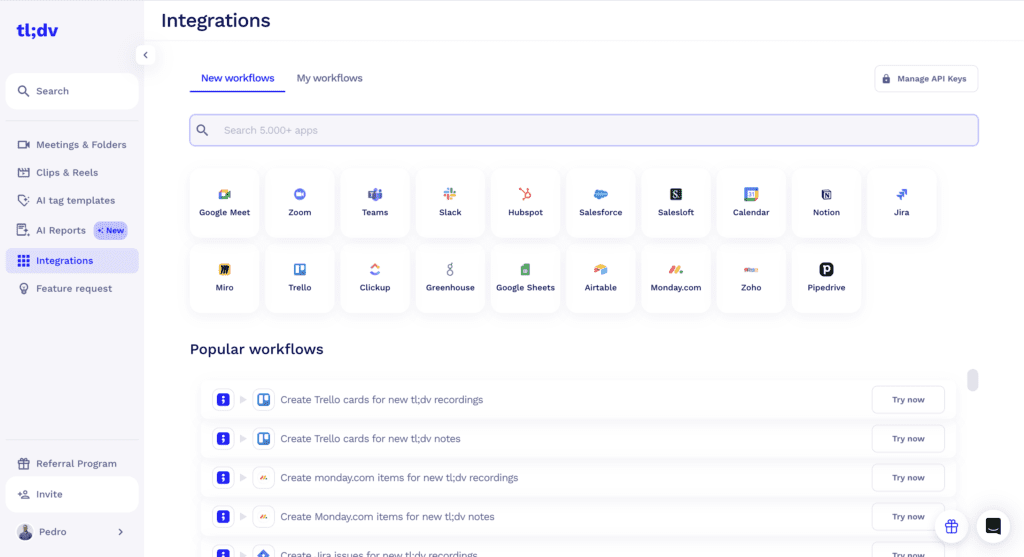
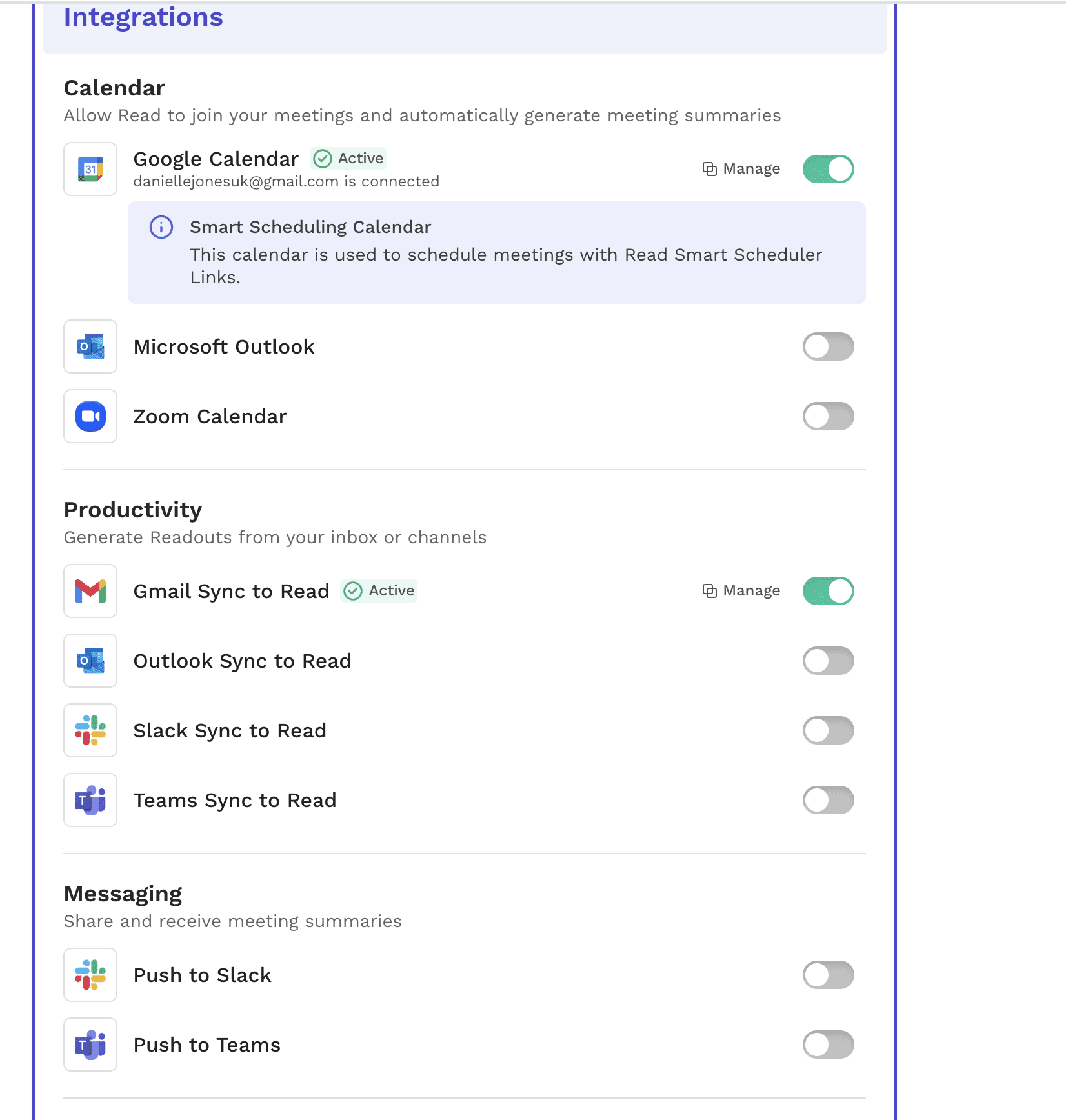
Intégrations CRM
Les intégrations CRM sont disponibles avec tl;dv pour les utilisateurs souscrivant au plan Pro, permettant un flux de données transparent entre les outils de gestion des réunions et les outils de gestion de la relation client.
Read.ai offre des capacités d'intégration CRM grâce à l'utilisation de webhooks sur ses plans payants. C'est une bonne chose pour une offre plus personnalisée, mais cela nécessite des coûts et une configuration supplémentaires.
Rapports programmés
tl;dv offre une fonctionnalité de rapports programmés qui peuvent être configurés et personnalisés en fonction de l'individu, du département et d'une série de déclencheurs. Ces rapports peuvent être établis en fonction d'un facteur chronologique (quotidien) ou en mettant en évidence un mot-clé ou une phrase spécifique qui envoie un rapport automatique. Cela signifie que, par exemple, le responsable d'un service commercial peut créer un rapport sur le nom d'un concurrent qui sera automatiquement généré. Ces données peuvent ensuite être utilisées pour identifier la manière dont les objections sont gérées, ou même quels sont les concurrents les plus fréquemment mentionnés à des fins de prévision.
Read.ai n'a pas cette capacité, et bien que des rapports puissent être générés, ils sont davantage liés à des réunions spécifiques. Cela signifie que si les utilisateurs individuels peuvent consulter leur page "Pour vous", celle-ci peut être davantage orientée vers les besoins et les préférences de l'utilisateur que vers ce qu'il a besoin de savoir.
Capacités de prise de notes
| tl;dv (12) | Read.ai (6) | |
|---|---|---|
| Notes IA | 🟢 | 🟢 |
| Notes manuelles pendant les appels | 🟢 appli requise | 🟢 appli requise |
| Mentions de personnes dans les notes | 🟢 | 🔴 |
| Attribuer des tâches | 🔴 | 🔴 |
| Étiquettes IA / Signets | 🟢 | 🟢 |
| Commentaires | 🟢 | 🔴 |
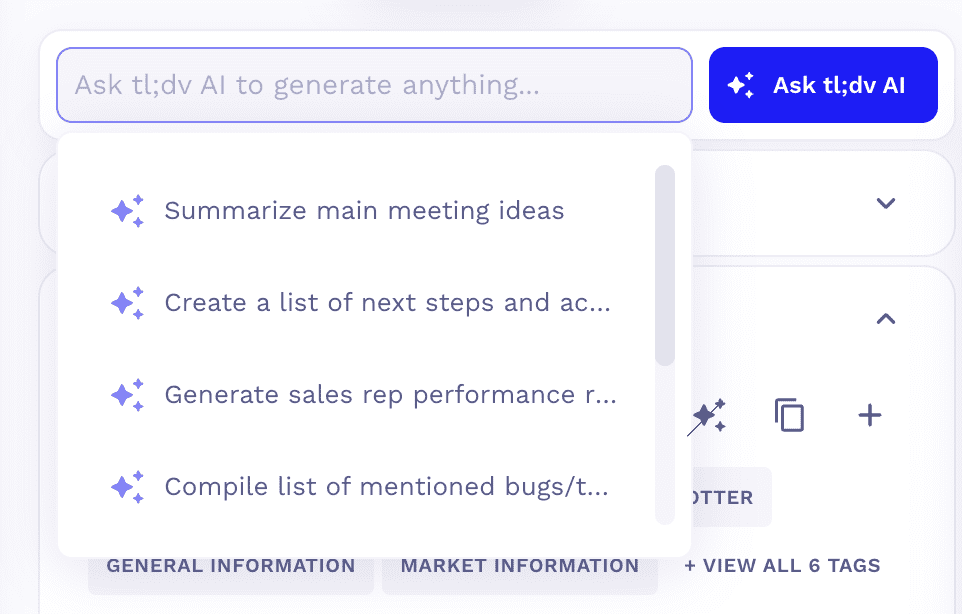
Notes IA
L'un des véritables avantages de tl;dvest qu'il permet à ses utilisateurs de personnaliser le type de notes qu'ils reçoivent après chaque réunion. Vous pouvez créer des "balises AI" et détailler chaque sujet pour lequel vous souhaitez que l'IA segmente votre réunion.
Read.ai, en revanche, se concentre sur l'automatisation de la génération de résumés de réunion, de transcriptions et d'éléments exploitables, sans possibilité explicite de personnaliser la segmentation des notes à l'aide de balises définies par l'utilisateur.
Mentionnez des individus dans les notes
tl;dv permet aux utilisateurs de marquer des personnes dans les notes, une fonctionnalité qui améliore la collaboration en reliant les points de discussion directement aux membres de l'équipe. Cette fonctionnalité facilite le suivi et la responsabilisation au sein des équipes.
Bien que vous puissiez marquer l'orateur après la fin de la réunion, Read.ai ne semble pas offrir la possibilité de marquer automatiquement les personnes dans les notes.
Assigner des tâches
Read.ai permet de créer des actions et utilise même l'IA pour créer des messages-guides en réponse à des requêtes et à des questions. Cependant, ses fonctionnalités ne semblent pas permettre d'assigner des tâches à des personnes, qu'elles soient présentes ou non dans les réunions.
Commentaires
La possibilité d'ajouter des commentaires sur les notes ou les transcriptions est disponible sur tl;dv, ce qui améliore encore ses fonctions de collaboration en permettant aux membres de l'équipe de discuter et de clarifier les résultats de la réunion au sein de la plateforme.
Read.ai permet aux utilisateurs d'apporter des modifications à leurs notes récapitulatives qui peuvent être partagées avec d'autres membres de la réunion. Il est également possible d'ajouter des notes privées. La capacité d'édition est clairement indiquée dans l'interface, mais elle n'est pas très claire à première vue.

Fonctionnalités de sécurité
| tl;dv (19) | Read.ai (8) | |
|---|---|---|
| Conservation des données | 🟠 6 mois sur le plan GRATUIT Illimité sur tous les plans payants | 🟢Cette option peut êtredéfinie en interne, mais uniquement pour les plans de niveau supérieur. |
| Conformité SOC2 | 🔴 (certification en cours) | 🟢 |
| Protocole SSO basé sur SAML | 🟢 Uniquement sur Enterprise | 🟢 Uniquement sur Enterprise |
| Conforme au RGPD | 🟢 | 🟠 |
| Conforme à la loi européenne sur l'IA | 🟢 | 🔴 L'analyse des sentiments est-elle si peu conforme ? |
| Utilise vos données pour former l'IA | 🟢 (Non, vos données restent confidentielles) | 🟠 (Oui, c'est un opt-in) |
| Stockage privé | 🟢 Uniquement sur Enterprise | 🔴 non divulgué |
| Données sensibles anonymisées envoyées aux LLM | 🟢 | 🔴 non divulgué |
| Fragmentation et randomisation des données de réunion | 🟢 | 🔴 non divulgué |
| Accords (BAA) avec les prestataires de LLM | 🟢 | 🔴 non divulgué |
| Politique de conservation des données fournisseurs pendant 0 jour | 🟢 | 🔴 non divulgué |
Conservation des données
tl;dv propose une politique de conservation des données claire, offrant 6 mois de conservation des données pour les utilisateurs de son plan gratuit et une conservation des données illimitée pour tous les plans payants.
Read.ai donne aux utilisateurs la possibilité de définir leur propre politique de conservation des données. Cette politique peut être définie par l'administrateur, mais elle n'est disponible que pour les plans de niveau supérieur.
Conformité SOC2
Alors que tl;dv est en train de devenir conforme à la norme SOC2, ce qui indique son engagement à atteindre des normes élevées de sécurité et de protection des données, Read.ai est déjà conforme à la norme SOC2.
Protocole SSO basé sur SAML
Le Single Sign-On (SSO) basé sur SAML est disponible sur tl;dv pour les utilisateurs du plan Enterprise, assurant une gestion sécurisée et rationalisée des accès pour les grandes organisations.
Read.ai propose un SSO basé sur SAML pour les utilisateurs de Team Plan, rendant ainsi les fonctions de sécurité avancées plus accessibles à un plus grand nombre de ses clients.
Conforme au RGPD
En tant qu'outil basé dans l'UE, tl;dv est entièrement conforme au GDPR. Read.ai ne déclare pas implicitement qu'il est conforme au GDPR sur son site. Il indique que de nombreuses entreprises avec lesquelles il travaille dans l'UE ont "examiné nos capacités et sont convaincues que les fonctionnalités et les caractéristiques que nous fournissons répondent aux attentes du GDPR, y compris les fonctions de notification et d'opt-out (qui varient en fonction de la plateforme)". Il s'agit d'un cas de "caveat emptor" pour les utilisateurs basés dans les pays qui exigent le GDPR. En ce qui concerne les fonctions d'exclusion, elles sont cachées dans les paramètres, et les notifications (d'après ce que nous avons constaté) arrivent après un certain délai lorsque le robot rejoint la réunion.
Conformité à la loi européenne sur l'IA
Basé dans l'UE avec des serveurs en Europe. tl;dv est conforme à la loi européenne sur l'IA, ce qui démontre son attachement à des pratiques éthiques en matière d'IA et à l'adhésion à la réglementation. Read.ai, avec son analyse des sentiments, signifie qu'il n'adhère pas à la loi européenne sur l'IA.
Stockage privé
Le stockage privé, une fonctionnalité essentielle pour les organisations qui donnent la priorité à la souveraineté et à la sécurité des données, est disponible sur tl;dv pour les utilisateurs Enterprise. La position de Read.aisur le stockage privé n'a pas été divulguée, ce qui pourrait avoir un impact sur le processus de prise de décision des utilisateurs ayant des besoins de stockage spécifiques.
Envoi de données sensibles anonymisées aux LLM
L'approche de Read.ai concernant l'anonymisation des données sensibles envoyées aux LLM n'est pas divulguée, ce qui laisse une lacune dans la compréhension de ses pratiques de traitement des données. Il semble que pour envoyer des données à un LLM, il faille y adhérer.
tltl;dv prend les données sensibles et les rend anonymes avant de les envoyer aux grands modèles de langage (LLM), une pratique qui renforce la protection de la vie privée et des données.
Fragmentation et randomisation des données de réunion
Afin d'éviter le risque de reconstruire des conversations complètes à partir des données traitées par les LLM et d'améliorer la sécurité des données, tl;dv utilise le regroupement et la randomisation des données.
En ce qui concerne Read.ai , la situation n'est pas claire, car l'entreprise ne divulgue pas ses pratiques en matière de regroupement et de randomisation des données des réunions, ce qui pourrait constituer un facteur critique pour les organisations qui se préoccupent de la confidentialité des données.
Accords (BAA) avec les prestataires de LLM
tl;dv confirme avoir conclu un accord d'association commerciale (Business Associate Agreement - BAA) avec les fournisseurs de LLM, ce qui garantit que la manipulation et le traitement des données sont conformes aux normes légales et réglementaires.
Read.aiLe statut des BAA avec les fournisseurs de LLM n'est pas divulgué, ce qui pourrait influencer la décision des utilisateurs exigeant des garanties documentées de protection des données et de conformité.
Politique de conservation des données à 0 jour avec les fournisseurs
tl;dv est très ouvert quant à la mise en place d'une politique de rétention des données de 0 jour avec les fournisseurs. Cela permet de s'assurer que le risque d'exposition des données est minimal et de garantir en toute confiance une conformité et une suppression immédiates de la part des fournisseurs de services tiers.
En consultant le site web de Read.ai, il n'y a pas de politique claire de conservation des données avec les fournisseurs, autre que leur politique de confidentialité qui stipule qu'ils ne sont pas responsables de leurs méthodes de suppression. Ils fournissent une liste de leurs sous-traitants, mais en tant qu'entreprise, ils ne semblent pas avoir la même politique que tl;dv.

Capacités de coaching
| tl;dv (8) | Read.ai (0) | |
|---|---|---|
| Cartes de score alignées sur des playbooks | 🟢 | 🔴 |
| Playbooks personnalisés | 🟢 | 🔴 |
| Modèles de playbooks | 🟢 | 🔴 |
| Traitement des objections | 🟢 | 🔴 |
L'élément que tl;dv excelle par rapport à Read.ai est l'accent mis sur le coaching des responsables et des équipes de vente, ainsi que d'autres acteurs de l'entreprise. Il existe une suite complète de fonctionnalités et de capacités orientées vers le coaching que Read.ai ne peut pas égaler.
Les principales caractéristiques sont les suivantes :
- Playbooks Cartes de pointage : Le suivi et le développement sont facilités pour le suivi des performances individuelles dans le domaine de la vente. Vous pouvez également créer un tableau de bord playbook pour n'importe quel ensemble de réunions.
- Custom Playbooks: Vos utilisateurs peuvent créer des documents cadres et playbooks de stratégies de réunion testées et approuvées. Ces documents peuvent ensuite être utilisés en réunion pour établir des comparaisons.
- Modèle Playbooks: Le plan de coaching comprend un certain nombre de modèles playbooks extrêmement utiles pour un certain nombre de fonctions et de départements. Ce modèle peut réellement aider les départements à adapter leurs stratégies de coaching.
- Produit (entretien de recherche, tests d'utilisation).
- Projet (planification du sprint, réunion préparatoire, brainstorming, lancement)
- RH (entretien d'embauche, entretien de sortie, entretien d'entrée).
- Réussite du client (réunion de rétrospective, analyse des activités, réunions d'accueil des clients, réunions de contrôle des clients, appels de retour d'information).
- Ventes (Demo call, MEDDIC, SPICED, BANT, Discovery call, GPCT, CHAMP, ANUM, BEBEDC, SPIN).
- Gestion (plan d'amélioration des performances, réunion 1:1, intégration 1:1, examen des performances).
- Traitement des objections : Les équipes de vente et de service clientèle disposent ainsi de tableaux de bord sur leur technique de traitement des objections.
Il y a du coaching sur Read.ai , mais il s'agit davantage d'améliorer la communication générale que la communication spécifique à la vente, et on pourrait probablement considérer qu'il s'agit plus d'une analyse de conférencier que d'un coaching à proprement parler.
Il s'agit d'une "notation" intelligente visant à améliorer la communication et l'efficacité. Elle est basée sur un certain nombre de facteurs, notamment le temps de parole, les mots de remplissage, et utilise le sentiment et le langage corporel des autres participants. C'est plus utile dans le sens où quelqu'un essaie de devenir un meilleur communicateur, et les capacités de l'IA peuvent faire des suggestions aux demandes, mais il s'agit d'un sens très large du coaching et probablement pas assez spécifique pour le coaching et les appels liés à la vente.
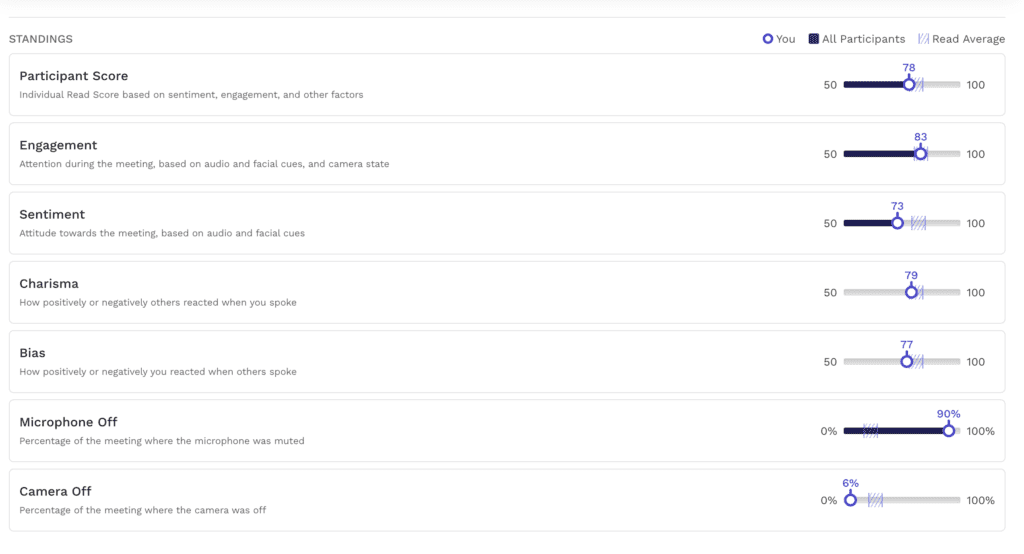

Capacités administrateur
| tl;dv (8) | Read.ai (4) | |
|---|---|---|
| Enregistrement automatique de toutes les réunions dans le calendrier des membres de l'équipe | 🟢 | 🟢 |
| Partage automatique des réunions enregistrées par les membres de l'équipe | 🟢 | 🟢 S i vous utilisez l'espace de travail de Read.ai |
| Blocage des suppressions | 🟢 | 🔴 |
| Droits d'administrateur sur tous les enregistrements | 🟢 | 🔴 |
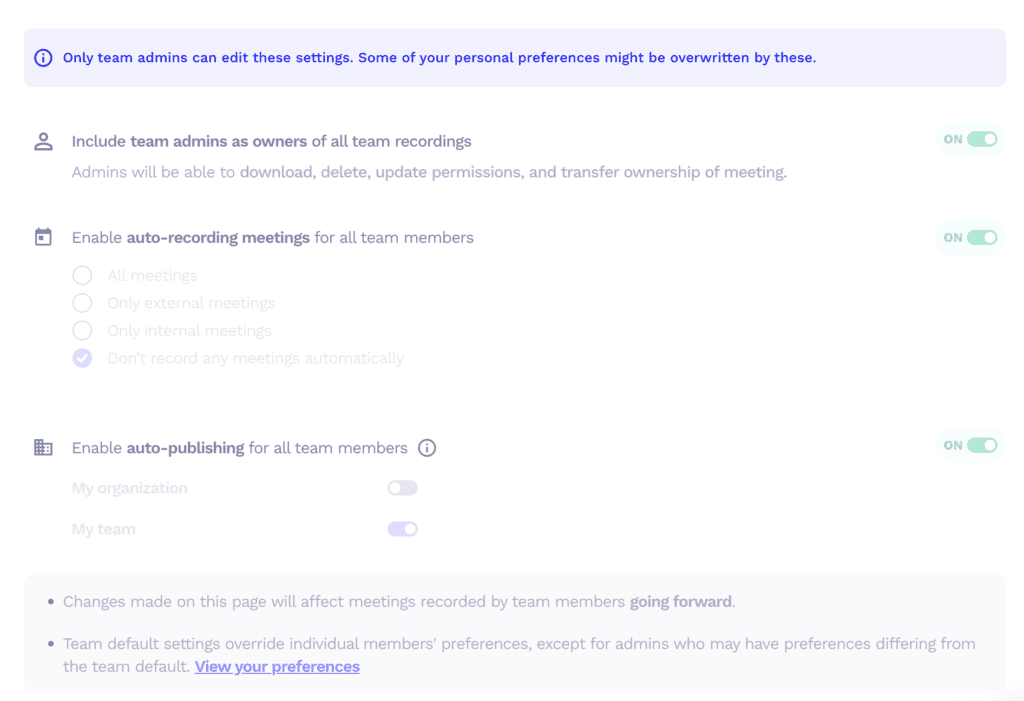
Enregistrement automatique de toutes les réunions dans le calendrier des membres de l'équipe
Les administrateurs peuvent appliquer des paramètres dans tl;dv qui garantissent l'enregistrement automatique de toutes les réunions programmées dans les calendriers des membres de l'équipe, ce qui est également pris en charge par des courriers électroniques automatiques envoyés aux participants pour confirmer qu'ils sont d'accord pour être enregistrés. Cela permet une action beaucoup plus transparente de pouvoir enregistrer tout, avec permission, sans effort de la part des personnes individuelles.
Read.ai est davantage axé sur les individus que sur les équipes. Cela signifie qu'il incombe à l'individu de mettre en place ce système et d'être connecté à un espace de travail avec d'autres individus. Cela signifie que tout ce qui est de cet ordre doit être défini au niveau individuel et n'est pas explicitement détaillé comme une option "à l'échelle de l'entreprise".
Partage automatique des réunions enregistrées par les membres de l'équipe
Là encore, le partage des réunions peut être configuré comme un "partage automatique" par les administrateurs à l'aide de tl;dv. Cela permet de s'assurer que la distribution du contenu des réunions est facile et sans effort, ce qui permet une meilleure collaboration et une meilleure communication. Cela permet également un partage beaucoup plus transparent et réfléchi des informations lors des réunions.
D'autre part, Read.ai met généralement l'accent sur les configurations pilotées par l'utilisateur pour le partage des informations et des enregistrements des réunions. Les capacités de partage peuvent être gérées par des paramètres individuels ou éventuellement par l'intégration avec d'autres outils de collaboration à l'aide de leur API ou de la prise en charge des webhooks.
Blocage des suppressions
L'un des principaux avantages de tl;dv est la suppression préventive. Elle est très importante pour garantir la sécurité et la transparence des données dans un contexte interne. Les administrateurs peuvent s'assurer que cette mesure est mise en œuvre pour éviter toute suppression accidentelle ou intentionnelle des réunions et de leur contenu. Cela permet d'assurer une transparence et une clarté totales, et de constituer des archives beaucoup plus vraies et précises de chaque choix et de chaque mention faite lors des réunions.
Read.ai se concentre à nouveau sur l'individu qui utilise l'outil plutôt que sur une politique à l'échelle de l'entreprise. C'est donc au "propriétaire" de la réunion qu'il revient de décider comment celle-ci est stockée ou supprimée. Bien qu'une réunion puisse être partagée dans un espace de travail, si elle est supprimée du tableau de bord du propriétaire, elle sera entièrement retirée du système. Un certain nombre de conditions hiérarchiques peuvent être annulées par cette simple action, ce qui souligne la nécessité de gérer soigneusement les autorisations des utilisateurs et de savoir qui est propriétaire du contenu des réunions.
Pour illustrer cela dans un scénario hypothétique, un représentant commercial, après avoir tenu une réunion importante avec un prospect, se rend compte qu'il a fait une déclaration ou une promesse incorrecte qui pourrait potentiellement compromettre l'accord ou présenter de manière erronée les capacités de l'entreprise. Dans un moment de panique, le représentant décide de supprimer l'enregistrement de l'appel de son tableau de bord Read.ai , pensant ainsi éviter toute retombée.
Le directeur commercial, qui est chargé de superviser l'équipe de vente et de veiller à ce que toutes les interactions avec les clients respectent des normes élevées de professionnalisme et d'exactitude, décide d'examiner les réunions récentes dans le cadre d'un contrôle de routine ou peut-être parce que le prospect mentionne quelque chose d'anormal.
Si la réunion a été enregistrée à l'aide de tl;dv, le directeur commercial a la possibilité, si elle a été configurée au préalable, d'empêcher la suppression de tout enregistrement de réunion. Cela signifie que, même si le commercial tente de supprimer l'enregistrement de la réunion, celui-ci reste accessible.
Avec Read.ai, si le commercial est le propriétaire du rapport de réunion et qu'aucune mesure préventive n'est définie contre la suppression, l'enregistrement sera supprimé avec succès du système lorsque le commercial l'enlèvera. Lorsque le directeur commercial examinera cette réunion, il constatera qu'elle n'a pas été enregistrée. Le directeur commercial n'a qu'une visibilité limitée sur ce qui a été discuté ou promis au cours de l'appel, ce qui rend difficile de rectifier la situation ou de coacher correctement le commercial sur la base de ses performances réelles.
Capacités organisationnelles
| tl;dv (12) | Read.ai (10) | |
|---|---|---|
| Espaces de travail en équipe | 🟢 | 🟢 |
| Bibliothèque de réunions | 🟢 | 🟢 |
| Filtres intelligents | 🟢 | 🔴 |
| Recherche globale | 🟢 | 🟢 |
| Recherche dans les réunions | 🟢 | 🟢 |
| Dossiers | 🟢 | 🟢 |
Espaces de travail en équipe
Read.ai et tl;dv proposent tous deux des espaces de travail dans leurs plans. Cela signifie qu'il y a un espace de travail partagé pour que tout le monde puisse travailler de manière collaborative et offre le partage de contenu dans des espaces pour tous les utilisateurs. Chez tl;dv , il s'agit de l'offre de base, tandis que chez Read, il s'agit d'un point d'option, le compte étant détenu par l'individu et permettant de se connecter ensemble.
Filtres intelligents
L'utilisation de filtres intelligents est l'un des moyens utilisés par tl;dv pour améliorer l'efficacité de la recherche et de l'accès aux réunions. Il est ainsi extrêmement facile de trouver la bonne réunion, le bon participant ou la réunion de prospection mémorable lors d'une recherche.
Read.ai n'offre pas actuellement cette fonctionnalité. Bien que l'espace de travail soit consultable, l'identification du contenu que vous recherchez, plutôt que ce que l'IA propose, peut prendre plus de temps qu'avec tl;dv.
Dossiers
Les deux plateformes permettent d'organiser et de catégoriser facilement les réunions. Dans tl;dv , cela se fait sous la rubrique Dossiers, alors que Read.ai offre ses aspects organisationnels plutôt sous forme de tags, de filtres simples et de fonctionnalités de recherche. Ceux-ci peuvent être utilisés pour catégoriser et accéder facilement à diverses réunions ou appels sur la base de différents critères tels que la date, les participants ou le contenu, mais ne les place pas dans des dossiers spécifiques.
Support client
| tl;dv (4) | Read.ai (3) | |
|---|---|---|
| Support client sur le plan gratuit | 🟢 chat & email | 🔴 |
| Assistance prioritaire | 🟢 dans le plan Pro | 🟢 Uniquement dans le plan Entreprise |

Support client sur le plan gratuit
tl;dv fournit une assistance complète aux utilisateurs de son plan gratuit, à la fois par chat et par courrier électronique, garantissant que les utilisateurs disposent de plusieurs canaux pour demander de l'aide et résoudre leurs problèmes.
Cette approche facilite une assistance rapide et accessible à tous les utilisateurs, quel que soit leur niveau d'abonnement.
Read.ai L'assistance repose en grande partie sur leur centre d'assistance et sur une offre de chatbot. Lorsqu'ils posent des questions, les utilisateurs sont dirigés vers une liste d'articles pré-rédigés ou il leur est suggéré d'entrer en contact avec l'équipe d'assistance par le biais d'un formulaire. Il n'y a pas d'assistance immédiate disponible sur le chat, et les questions posées au chatbot et au centre d'assistance n'ont généralement pas reçu de réponse directe.
Assistance prioritaire
L'assistance prioritaire est disponible sur tl;dv à partir du plan Pro, offrant un niveau de service client amélioré aux utilisateurs des abonnements de niveau supérieur.
Read.ai fournit également une assistance prioritaire, mais uniquement pour les personnes ayant souscrit à l'offre Enterprise ou à une offre supérieure.
Cette fonctionnalité souligne l'engagement des deux plateformes à fournir une assistance de qualité supérieure à leurs utilisateurs les plus précieux, même si les critères d'accès sont différents.
Capacités d'analyse des données de vente
| tl;dv (0) | Read.ai (0) | |
|---|---|---|
| Prévisions | 🔴 | 🔴 |
| Exécution des opportunités | 🔴 | 🔴 |
Pour l'instant, tl;dv et Read.ai n'offrent pas de fonctionnalités commerciales améliorées liées à la Revenue Intelligence, telles que les prévisions et l'exécution des contrats.
Si vous souhaitez investir dans ces domaines, il est probable que vous deviez opter pour un autre outil, qui peut toutefois s'avérer très coûteux. Pour vous donner une idée de ce que cela peut représenter, certains des outils de vente du marché qui proposent des prévisions et l'exécution de transactions sont facturés plus de 1 000 dollars par utilisateur et par an.
Par exemple, un outil coûte 1 600 dollars par utilisateur et par an pour 49 utilisateurs ou moins. Pour une équipe de 49 personnes, cela représente un coût de 78 400 dollars avant même qu'une vente ne soit réalisée.
Si vous recherchez au moins un peu de coaching directement lié aux ventes, tl;dv dispose d'une bonne fonctionnalité intégrée.
À qui ces solutions sont-elles destinées ?
| tl;dv (8) | Read.ai (5) | |
|---|---|---|
| Classement G2 | 🟢 4.8 | 🟠 4.3 |
| Facilité de configuration | 🟢 Plan gratuit généreux + Interface utilisateur épurée | 🟢 OK, mais l'intelligence artificielle peut être difficile à comprendre |
| Plateforme localisée | 🟢 (7 langues) | 🔴 |
| Meilleur public cible | 🟢 Ventes aux PME | 🟢 U.S. Corporate Training |
Chaque outil s'adresse à des publics similaires, mais légèrement différents, le facteur clé étant la propriété du compte global et des licences.
Il est très utile pour les organisations qui travaillent avec des équipes internationales, car il permet d'enregistrer, de transcrire et de résumer les points clés d'une réunion sur plusieurs fuseaux horaires et dans plusieurs langues.
Les personnes qui bénéficieraient vraiment des fonctionnalités de tl;dv seraient les responsables des ventes, les représentants des ventes, les responsables de la réussite des clients, les chefs de produit et toute personne travaillant dans un réseau plus large - que ce soit en interne ou en externe.
Pour Read.ai, il s'agit probablement d'une entreprise plus axée sur les États-Unis, qui cherche idéalement à accroître la confiance des individus dans ses rangs. Les recommandations de l'IA en matière de métriques d'expression orale sont parfaites pour tous ceux qui cherchent à être plus charismatiques ou à éviter les préjugés dans leur capacité à s'exprimer. La principale chose dont il faut être conscient est que l'analyse des sentiments peut rendre ce logiciel inadapté à de nombreuses entreprises basées dans l'Union européenne.
Read peut être utile pour avoir une vue d'ensemble des "sentiments", donc partout où vous devez être conscient de la communication non verbale d'un client. Cet outil convient parfaitement aux professionnels des ressources humaines, aux spécialistes du marketing et aux formateurs d'entreprise aux États-Unis, qui peuvent tirer profit de la compréhension et de la réponse aux signaux non verbaux et au ton émotionnel des communications. Il permet à ces professionnels d'affiner leurs stratégies de communication, de renforcer l'engagement et de favoriser un environnement positif, sans les problèmes juridiques qui pourraient survenir dans des régions où les réglementations en matière de confidentialité des données sont strictes, comme l'Union européenne.
Verdict : tl;dv vs Read.ai - lequel est le meilleur ?
| tl;dv | Read.ai | |
|---|---|---|
| Transcription | 20 🟢 | 18 |
| Enregistrement | 16 🟢 | 12 |
| Intelligence conversationnelle | 14 🟢 | 9 |
| Automatisation et intégrations | 9 🟢 | 8 |
| Prise de notes | 12 🟢 | 8 |
| Sécurité | 19 🟢 | 8 |
| Coaching | 8 🟢 | 0 |
| Administrateur | 8 🟢 | 2 |
| Organisationnel | 12 🟢 | 9 |
| Service client | 4 🟢 | 2 |
| Revenue Intelligence | 0 | 0 |
| Autres | 8 🟢 | 5 |
| Total | 130 🟢 | 81 |
Dans cet examen détaillé de deux plateformes - tl;dv vs Read.ai - la décision de toute personne à la recherche d'un assistant de réunion IA devrait toujours être basée sur ses propres besoins et exigences organisationnels.
Sur la base de ce que nous avons appris ci-dessus ,tl;dv se distingue comme une plateforme plus polyvalente avec une gamme solide de fonctionnalités (et de fonctionnalités à déployer) qui pourraient être bénéfiques pour les opérations générales de l'entreprise, ainsi que pour les équipes de vente des PME.
Ces atouts sont mis en évidence par l'assistance linguistique, la transcription, l'enregistrement, l'intelligence conversationnelle et les capacités de coaching améliorées. L'engagement de l'entreprise en faveur de la satisfaction des utilisateurs, de la sécurité et des mesures de confidentialité des données basées sur les règles plus formelles et plus strictes de l'UE en fait un bon choix pour toute personne opérant à l'échelle internationale.
Read.aiBien qu'il soit le moins bien noté, il offre des fonctionnalités utiles, ainsi qu'une efficacité et une simplicité opérationnelles. Avec des mesures élevées basées sur l'analyse des sentiments, il peut constituer un excellent moyen de suivi pour les utilisateurs qui cherchent à accroître leur productivité et à améliorer leurs compétences en matière de communication.
Pour les organisations qui mettent l'accent sur des processus de vente avancés, qui ont besoin d'une assistance dans plusieurs langues et qui ont besoin d'une plateforme offrant un large éventail de fonctionnalités pour améliorer les résultats des réunions, tl;dv est le choix recommandé. Elle peut fournir des informations analytiques approfondies, des rapports automatisés pour une efficacité maximale et des outils de coaching visant à améliorer les performances de l'équipe de vente, mais sans un prix de plusieurs milliers d'euros par utilisateur.
Si l'exigence première est la transcription rationalisée et en temps réel dans le cadre de réunions en anglais et la prise de notes efficace, Read.ai est une option appropriée, en particulier pour ceux qui recherchent la simplicité opérationnelle.
tl tl;dv et Read.ai offrent tous deux des avantages substantiels, mais l'ensemble de fonctionnalités plus étendu de tl;dvet les taux de satisfaction plus élevés des utilisateurs le positionnent comme l'outil le plus complet et le plus adaptable pour les équipes qui souhaitent améliorer l'efficacité et la productivité de leurs réunions grâce à un assistant d'IA avancé.


